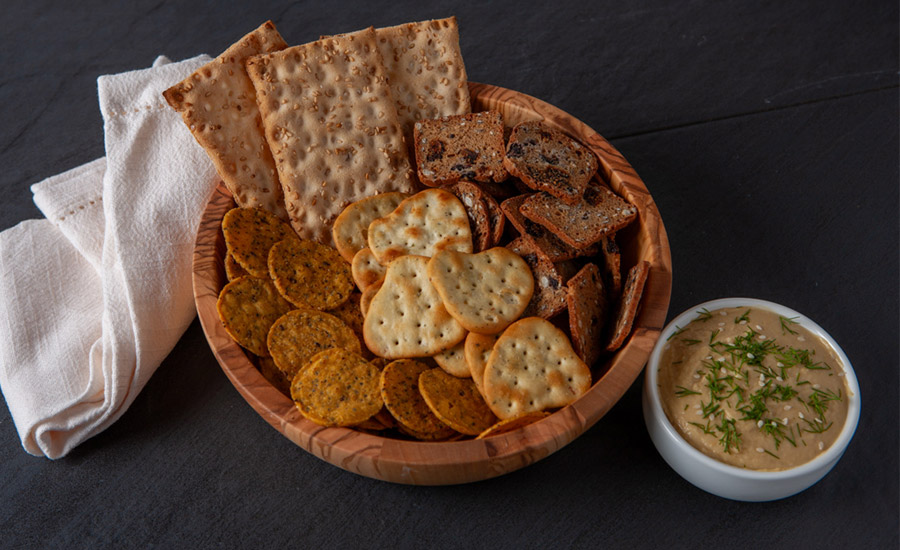Grains appeal to producers looking for nutritional and sustainability benefits
Grains are of increasing interest to producers looking for nutritious and sustainable ingredients.

Courtesy of Healthy Food Ingredients
The bottom line
- U.S. consumers don’t get enough fiber in their diets
- Gluten-free items continue to draw consumer interest
- Sustainable sourcing is a growing concern
The Dietary Guidelines for Americans recognize grains as an important part of a healthy eating pattern. Grain foods provide dietary fiber as well as essential vitamins (i.e., folate, thiamine, niacin, vitamin B6, riboflavin, and vitamin A) and minerals (i.e., iron, zinc, manganese, copper, magnesium, phosphorous, and selenium). However, grain foods account for just 15% of calories in an average American diet. Despite this, grains remain the largest source of fiber in the American diet—an important consideration given nearly 85% of Americans fall short of the daily recommended fiber intake.
In addition to nutrition, a proprietary study conducted by ADM shows that sustainability claims like “sourced from regenerative agriculture” resonate with consumers and have a strong impact on their purchase decisions. Grain ingredients that can help bakery and snack brands tell a sustainability store are increasingly attractive to consumers.
New ingredients and uses
Healthy Food Ingredients has launched a milled chia and a milled sunflower kernel. Jennifer Tesch, chief marketing officer for Healthy Food Ingredients, says, “Our milled sunflower kernel provides water absorption and creates a strong dough structure, along with the emulsion capacity needed to stabilize water-oil molecules. Milled chia boasts gelation and water absorption properties as well as a desirable mouthfeel. It is a good source of fiber and provides Omega 3 fatty acids.” These better-for-you ingredients can be used individually or blended together and are clean-label, gluten-free, and can fit into a keto or vegan diet. The milled sunflower kernel works well in breads, cookies, and cracker applications, while the miller chia is a great fit for energy bites, bars, and as an egg replacer in baking.
Grain Processing Corp. has launched FYBRIN RS, a resistant starch made from corn. FYBRIN RS reportedly can easily be incorporated into baked goods and snacks to add fiber, reduce calories, and lower net carbs. It is suited for tortillas and snacks and lends itself to gluten-free applications since it is produced from corn.
Kelly Belknap, business development manager, specialty ingredients, Grain Processing Corp., relates, “As the superfood trend continues, Grain Processing Corp.’s steamed chickpea flour has gained a lot of interest due to the ongoing consumer curiosity with chickpeas. Our proprietary steaming process improves the flavor profile of traditional ‘raw’ chickpea flours, allowing consumers to enjoy snacks and cereals with the goodness of chickpeas without the strong beany or off notes. In addition, chickpea flour can provide added protein, fiber, and some vitamins and minerals.” The combination of FYBRIN RS and chickpea flour reportedly has been shown to be very effective in gluten-free cracker formulations.
“From gluten-free and grain-free to keto and paleo, lifestyle diets continue to be important to many consumers. Grain alternatives and flour replacers can help support these eating habits and lifestyle diets,” states Paula LaBine, marketing director, milling and baking solutions, ADM. To meet these needs, ADM recently launched HarvestEdge Gold Keto-Friendly Flour Replacer which is a 1:1 flour replacer that can provide a smooth transition into existing production processes for pizza crusts, breads, biscuits, tortilla, pancakes, and crackers. “Our new HarvestEdge Gold Keto-Friendly Flour Replacer has a clean, neutral flavor and outstanding texture and functionality. It is also an excellent source of fiber,” adds LaBine.
ADM has recently expanded their HarvestEdge Gold line with sustainably sourced options for their wheat and sorghum products. The line includes sorghum flour and a range of Food Alliance sustainable flours (a Food Alliance certification is a voluntary way for agricultural producers and other food companies to address the growing customer and consumer demands for traceability, transparency, and social and environmental stewardship). “Our HarvestEdge Gold sorghum is a special white variety, along with being non-GMO, certified gluten-free and processed in ADM’s verified net carbon-neutral mill in Dodge City, Kansas. With its light color and sweet, nutty flavor, our sorghum is an exceptional grain solution to elevate baked goods and snacks, from cereals to breads and cookies to cakes. HarvestEdge Gold certified sustainable flours (high protein, low protein, whole wheat, and pastry fours) are locally and direct-sourced near our Spokane, WA mill and offer third party endorsement of sustainability credentials,” shares LaBine.
Cargill notes that manufacturers are turning to whole grain ingredients to improve the nutritional profile on their products, and therefore have seen an uptick in the interest of whole grain corn products, especially within the snack space. “Because corn ingredients serve as a base for many snack applications, switching to whole-grain corn ingredients can be an easy way for brands to improve the nutrition density of the products,” shares Keyla Rodriguez, technical services manager, Cargill.

“Switching from refined corn flour to whole grain corn flour will create a new sensory experience, thanks to a higher level of protein, fiber, and oil. By using whole grain corn flour, snack manufacturers can create a more artisanal experience, with unique textures and a stronger, more robust flavor as compared to refined corn flour, which tends to be slightly sweeter. Products made with refined flour are typically softer and smoother, while those formulated with whole-grain corn flour offer a heartier texture thanks to its higher level of fiber. Finished snacks made with whole grain corn flour are also typically slightly darker than those produced using refined corn flour,” says Rodriguez. Cargill offers a wide range of whole grain corn flours that can be used in snacks, nutrition bars, tortilla chips, and other corn-based chips, and crackers.
Grain ingredients such as high-fiber wheat flour has been gaining traction in the baking industry according to Batory Foods. The company offers a high-fiber wheat flour that offers 10x more fiber than traditional wheat flours and can be used in pasta, tortillas, pizza crusts, bread products, and sweet goods. Another product is their hull-less oats which contains 40% more protein than traditional oats and can be used in any application currently utilizing conventional oats.
Ancient and new
Batory Foods is seeing renewed interest in ancient grains. “Some consumers and developers may say that is ‘ancient’ news, but market indicators are telling us what was old is new again,” shares Heather Kuntz, business development manager for bakery at Batory Foods. “Ancient grains are a wholesome, minimally processed nutritional powerhouse that can help add a wide variety of tastes, textures, and nutritional boost to food and beverage products. Ancient grains can be processed into a wide variety of formats such as crisping, flaking, milled flours, popping, and pasteurized whole grains. These versatile ingredients can provide unique crispy textures and inclusions in bars, snacks, and breakfast cereals, visual appeal, and enhanced texture of baked goods, and add a variety of health-related claims like gluten-free, high fiber, high protein, non-GMO, and organic.”
The company expects to see increased interest in high-protein, high-fiber options that are also gluten-free and sustainable, and millet, sorghum, and buckwheat are at the top of the watch list. Kuntz describes the benefits for each of these ancient grains.
- Millet is a good source of fiber, high in protein and vitamins. Millet is most often used as a topping on multi-grain style breads either traditional or gluten-free. Millet flour is gaining popularity as a versatile flour that can add volume and tenderness to baked goods, is an excellent substitute for wheat flour in gluten-free baked goods, breads, wraps, and flatbreads, and can be combined with oat flour, rice flour, or tapioca flour all-purpose gluten-free blend. Millet is considered a hardy crop, which grows well in hot dry climates, requiring less water and fertilizers, it can withstand drought conditions making this crop top of the list for sustainability.
- Sorghum is rich in fiber, antioxidants, 12 essential nutrients, and is naturally gluten-free. It has a mild wheat flavor profile that lends itself to be utilized across many bakery platforms—breads, cookies, cakes, snacks, cereals, and bars. Customers looking to improve their digestive health and immunity will benefit from Sorghum’s excellent source of fiber, protein, zinc, selenium, and copper. Sorghum is the fifth largest crop in the world, after corn, rice, wheat, and barley, with the U.S. being the world’s largest producer.
- Buckwheat is considered a pseudocereal, however, it is not considered a cereal grain or related to wheat and is considered gluten-free. Buckwheat contains a good amount of fiber and resistant starch and is high in minerals manganese, cooper, magnesium, iron, and phosphorus. While Buckwheat is relatively low in vitamins, it is richer in antioxidants than many common cereal grains. It provides a nutty profile and is commonly used in soba noodles and pancakes; however, it is finding its way into breads, chips, crackers, and baking mixes.
Gluten-free growth Free Continues to Grow
According to Innova Market Insights shared by Batory Foods, gluten-free continues to be in the top three claims in the total bakery category, joined by GMO-free and no additives/preservatives. Of the new product launches, almost half of the U.S. gluten-free launches were also GMO-free. Bakery mixes with gluten-free claims continue to dominate the bakery subcategories, followed by crackers/biscuits (savory), and cookies/biscuits (sweet). Cake-sweet goods and bread subcategories remain relatively flat.
“Rice flour continues to be the most frequently used flour in gluten-free bakery, we are seeing increases in almond flour, chickpea, and buckwheat flour in gluten-free bakery innovation. Innova Market Insights indicated that plant-based claims on bakery launches have grown rapidly since 2018 and the percentage of plant-based claims on gluten-free launches is also on the rise. More than 60% of plant-based launches also had vegan and/or gluten-free claims,” shares Kuntz.
“Many advances have been made in designing gluten-free and plant-based bakery products with improved texture, flavor, and nutrition. Formulators are no longer designing around one alternative grain but a combination of gluten-free grains and plant-based ingredients that work synergistically to provide functional properties, textural expectations, advanced nutritional attributes, desired flavor, and visual appeal consumers desire,” states Kuntz.
Grain Processing Corp. recently conducted proprietary research with current gluten-free baked goods consumers. “Survey respondents indicated that they are searching for gluten-free products with added nutrition. When specifically asked what nutritional parameters they would like to see improvement on, added protein and added fiber were on the top of the survey. Enhancing the nutrition of current gluten-free bakery and snack items should be a priority in this category,” shares Belknap.
The selection of grains for snack and bakery products will continue to grow with a focus on nutrition and sustainability.Looking for a reprint of this article?
From high-res PDFs to custom plaques, order your copy today!





